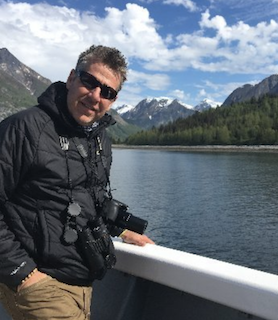Canadian Geographic names Geography teacher of the month: Peter Cameron
Monday, September 10, 2018 /

Peter Cameron (BA/B.Ed 1994) is self-described “M.A.D.” man. In other words, he wants to “make a difference” and teach his students to do the same.
Cameron, who’s been a teacher for 24 years, currently teaches Grade 5/6 at St. Elizabeth’s School in Thunder Bay, Ont. He is also the co-founder of M.A.D. PD, or Make a Difference - Professional Development, which brings together educators from around the world to share one idea that makes a difference in their classroom.
This coming school year, Cameron’s students, as well as students from other schools, will become Junior Water Walkers as part of a new project to raise awareness about the importance of freshwater.
On how the Junior Water Walkers got started
At the beginning of every school year, I use the book Paddle-to-the-Sea to give my kids a sense of their place in the world and to have them understand how great the Great Lakes are. I also use Google Earth and as we’re reading the book we track the journey of that little boy in the canoe travelling though the Great Lakes. I became connected with Google Earth and they really liked how I was using the tool in the classroom, so we came up with the idea of a Voyager story. The intent there was to take the kids through a thematic adventure and have them understand that the Great Lakes are now at risk.
Then, in April of this year, I was walking with my son and our exchange student along one of the small lakes in Thunder Bay and we crossed paths with a woman dressed in traditional Anishinaabe clothing and carrying a copper bucket and a staff. Later, I opened up a magazine and there was a review of a book called The Water Walker. On the cover was a picture of a younger Josephine Mandamin — it was a story about the woman we had seen walking! I reached out to her and found out that she had walked all around the five Great Lakes to bring awareness to water issues. Josephine now has Parkinson’s disease and can no longer do her lengthy walks, so my students had the idea to become Junior Water Walkers and kind of take up her cause.
On continuing Josephine’s work
We’re challenging other classes to join us in honouring her great work and the Anishinaabe traditions. She’s very excited about it as well. The idea is that we’ll spend time learning about water and how great our waterways are, but then also understanding that they’re at risk. Then we’ll choose a body of water to adopt. Then maybe we’ll bring in a conservationist and learn about different ways that we can protect that body of water and all waterways. In the springtime, we’ll do our water walk and invite either Josephine or an Anishinaabe Elder and they’ll share some of the traditions around water. Hopefully, classes throughout the world will do the same. We’ve already got 24 classes registered! Many are around the Great Lakes, but we have classes from British Columbia and even Thailand.
On his “M.A.D.” classroom philosophy
I believe it’s important to have a motto that brings your class together and gives your class a focus. Our motto is “We can make a difference.” We decided we wanted to have a “make a difference” podcast, M.A.D. The podcast happens throughout the school year. We had an episode where we shared about how we believe that Josephine is a difference maker. I became a teacher to make a difference for students, but it’s an even greater gift when we can teach our students that they can make difference. Every day is an adventure when I go into the classroom. I grew up seeking adventure in my own life, but what I love now is that sense of adventure that I can bring to my classroom.
On the use of technology in the classroom
It’s amazing what we can do now and what we can bring to our classroom. Before, my resources were the books and binders on my shelf. I don’t know that I would’ve found Josephine if it wasn’t for technology. I found her on Facebook. The opportunity to connect with people and bring their stories to our classrooms, whether or not it’s face-to-face, is amazing.
And you can see how the students form a personal connection to these people who we’ve brought virtually to our class. We’ve had a photographer from National Geographic, we’ve gone on virtual field trips to a turtle rescue hospital, we’ve gone to Antarctica, and gone cave diving. When my students can talk with these people and ask questions, their desire to learn is astounding. It’s completely changed the way I teach and the way my students learn.
To view more visit: https://youtu.be/g7f3w41PqZc
By Tanya Kirnishni
September 3, 2018

